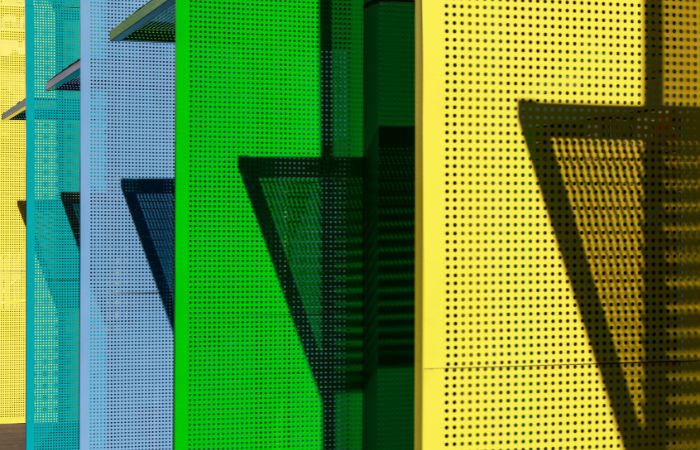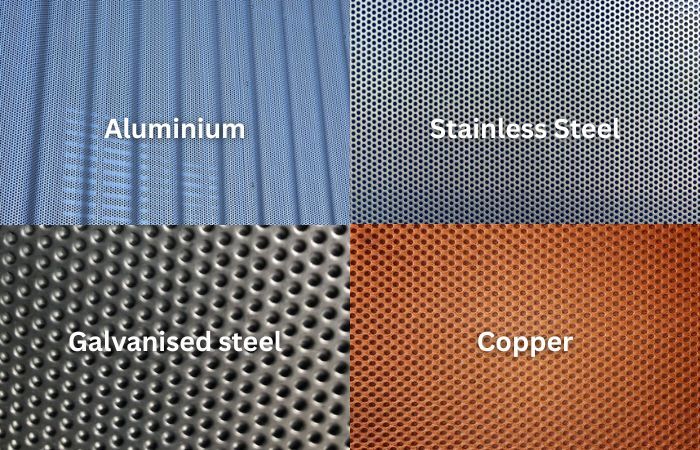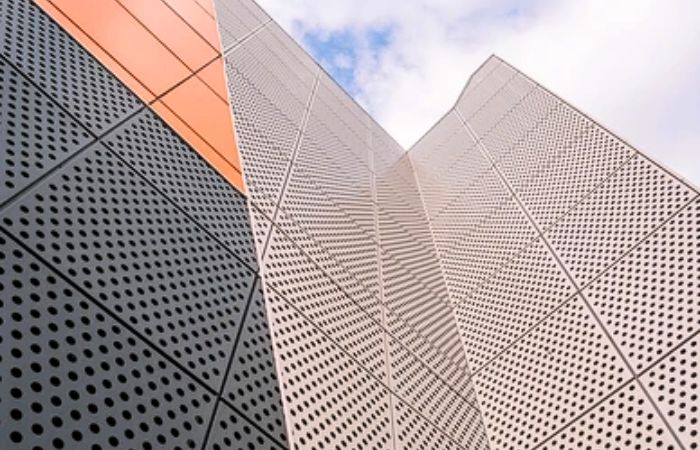Why Australian Designers and Builders Are Turning to Perforated Metal
Posted by A1 Metal Mesh on 15th Oct 2025

Perforated metal has become one of the most adaptable materials in Australian architecture, manufacturing and construction. From sleek building façades and sunscreens to mining screens and soundproof panels, it combines form and function like few materials can. Strong, durable and visually striking, perforated metal continues to redefine how Australians design, build and innovate.
What Is Perforated Metal?
Perforated metal is a sheet of metal that has been punched, stamped or laser-cut to create a pattern of holes, slots or decorative shapes. The result is a lightweight yet robust material that allows light, air and sound to pass through without compromising strength. It is typically made from stainless steel, aluminium, galvanised steel, brass or copper, each offering unique advantages.
Patterns can be round, square, slotted or custom-designed to achieve specific performance goals, from ventilation and filtration to acoustic control and aesthetics. This versatility is what makes perforated metal indispensable across industries.
Common Questions Answered About Perforated Metal
What thicknesses are available?
Perforated metal is available in a wide range of thicknesses, from lightweight 0.5 mm aluminium to heavy-duty 5 mm stainless steel, depending on the load-bearing requirements.
Can it be used outdoors?
Yes. Stainless steel, aluminium, and powder-coated galvanised steel perforated sheets are highly weather-resistant and ideal for exterior applications, such as cladding, sunscreens, and fencing. Protective coatings or powder-coated finishes can further enhance their lifespan.
Is it sustainable?
Yes. Perforated metal is 100% recyclable and contributes to energy efficiency by enhancing natural airflow and improving lighting. According to the Australian Bureau of Statistics, around 90% of steel used in Australian construction is recycled, highlighting its sustainability value.
Can the perforation pattern be customised?
Absolutely. Modern CNC and laser technologies allow fully customised hole sizes, shapes and patterns to meet specific design or performance needs.
What finishes are available?
Finishes include brushed, polished, powder-coated and anodised options, providing flexibility for both indoor and outdoor projects.
Comparison of Common Perforated Metal Materials
This table highlights how different metals cater to different needs. Stainless steel is ideal for industrial strength and longevity, while aluminium offers lightweight flexibility for design-led projects.
|
Material |
Key Features |
Best For |
Corrosion Resistance |
Weight |
|
Stainless Steel |
Strong, durable, low-maintenance |
Architectural facades, industrial use |
Excellent |
Heavy |
|
Aluminium |
Lightweight, corrosion-resistant, easy to shape |
Ceilings, sunscreens, decorative panels |
High |
Light |
|
Galvanised Steel |
Cost-effective, tough, weather-resistant coating |
Outdoor screens, security fencing |
Moderate to high |
Medium |
|
Brass |
Decorative, distinctive finish |
Interiors, feature walls, artistic installations |
Moderate |
Medium |
|
Copper |
Visually striking, develops natural patina |
Architectural design, luxury interiors |
High |
Medium |

How Perforated Metal Comes to Life
Perforated metal sheets are produced using precision punching or laser-cutting machinery. These systems ensure uniform patterns and exact hole alignment across the sheet. After perforation, sheets may undergo flattening and finishing to meet their intended purpose.
Finishes can include polishing for a smooth surface, anodising for colour and protection, or powder coating for enhanced weather resistance. Custom manufacturing enables architects and engineers to specify unique perforation patterns that elevate both performance and appearance.
Key Benefits of Perforated Metal
Strength and Durability
Perforated metal retains the strength of its base material while significantly reducing weight. It withstands impact, corrosion and harsh environments, making it a long-term investment for industrial and architectural projects alike.
Ventilation and Light Control
The perforations allow natural light and airflow while maintaining privacy and shade. This makes it an energy-efficient choice for facades, sunscreens and ventilation panels, reducing reliance on artificial lighting and cooling systems.
Acoustic Performance
When combined with sound-absorbing materials, perforated metal helps reduce noise and echo. It is widely used in factories, auditoriums and offices to improve acoustic quality and worker comfort.
Aesthetic Flexibility
Designers use perforated metal to achieve sleek, modern appearances while maintaining structural purpose. The customisable patterns and finishes give creative freedom in shaping light, shadow and texture across both interior and exterior applications.
Environmental Sustainability
Beyond recyclability, perforated metal contributes to sustainable building design by regulating heat and airflow. Its longevity also means fewer replacements and reduced waste, aligning with Australia’s move towards more sustainable construction practices.

Applications Across Australian Industries
Architecture and Construction
Perforated metal is a signature element of contemporary design. It is used in facades, stair treads, shading screens, railings and ceiling panels. Its ability to provide both beauty and performance makes it popular in public spaces, commercial buildings and residential projects.
Industrial and Mining
In the industrial and mining sectors, perforated metal plays a crucial role in sieving, filtering, and protective guards. It offers high strength, easy maintenance and long service life under demanding conditions.
Agriculture
Farmers use perforated metal in grain dryers, silos and ventilation systems to improve airflow while preventing debris accumulation and contamination.
Automotive and Transport
Lightweight and durable, perforated metal is used in vehicle grilles, filtration systems and soundproofing components to enhance performance and comfort.
Selecting the Right Perforated Metal
When choosing perforated metal for a project, consider the following factors:
- Material Type: Match durability and weight to the environment and function.
- Thickness: Thicker sheets for strength; thinner for design flexibility.
- Hole Shape and Size: Round for general use, slotted for ventilation, decorative for aesthetics.
- Open Area Percentage: Balances airflow, visibility and strength.
Working with a knowledgeable supplier ensures the right combination of these factors to meet both structural and design requirements.

Maintenance and Care
Perforated metal requires minimal upkeep. Cleaning with mild detergent removes dirt and pollutants, preserving its finish. For outdoor applications, protective coatings help guard against corrosion. Regular inspections keep structures safe and looking their best for years.
Australia’s Growing Demand for Perforated Metal Solutions
As Australia embraces sustainable architecture and efficient manufacturing, perforated metal is positioned to play an even greater role. Its adaptability, recyclability and aesthetic potential make it an ideal material for a wide range of innovative applications.
Selecting the right perforated metal is about more than just material choice; it is about balancing strength, design and environmental performance. At A1 Metal Mesh Screens, we deliver high-quality perforated metal solutions crafted for Australian projects. Our extensive range of materials, patterns and finishes ensures durability, precision and visual appeal.
Contact us today to discover how our perforated metal products can bring your next project to life.

